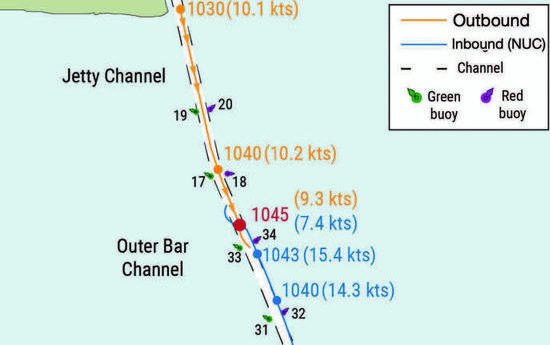202438 False engine alarm causes collision
As edited from NTSB (U.S.A.) report MIR-23-16Engine personnel on a partially loaded cargo vessel performed maintenance while at anchor to replace a failed cylinder head gasket. The vessel then took on a pilot and was inbound for the port to discharge the remaining cargo. Meanwhile, another vessel, also under pilotage, was outbound. The pilots had made arrangements over VHF radio to pass port to port at the Outer Bar Channel where the width of the navigable waterway was about 245m.
Shortly before the two vessels met, the main engine alarm detection panel on the inbound vessel recorded a high oil mist density reading, and the main engine shut down automatically. This also caused the loss of the bow thruster. The remaining electrical equipment and instruments, including the steering gear, continued to be powered. The vessel was now drifting and Not Under Command (NUC).


The pilot aboard the drifting NUC inbound vessel broadcast over VHF radio that the vessel had lost propulsion and the vessel started veering to port. The pilot ordered hard starboard rudder and instructed the captain to ‘sound the danger signal’. The pilot confirmed the rudder’s response on the rudder angle indicator, but, despite maintaining hard starboard rudder, the bow of the drifting vessel continued veering to port, across the channel and toward the path of the outbound vessel. Without propellor thrust the helm was virtually useless.
On hearing the VHF radio broadcast, the pilot of the outbound vessel ordered the vessel’s rudder hard to starboard and an increase of main engine speed by 10 rpm in an attempt to manoeuvre away from the approaching NUC vessel. Faced with the NUC vessel cutting across the channel, he ordered the rudder to midship, and then ordered a hard port rudder. He believed this manoeuvre was now the only way to avoid contact with the drifting vessel.
Two minutes after having lost main propulsion and with the NUC vessel still moving at a speed of 7.4 knots and the outbound vessel at 9.3 knots, the bow of the NUC vessel struck the port quarter of the outbound, peeling back about 12 metres of that vessel’s hull plating forward of the transom and wrapping it around the stern.
The official investigation found that the automatic shutdown of main engine on the inbound vessel was likely due to a false alarm. The investigation posited that the oil mist detector had sensed water vapour resulting from the engine maintenance and incorrectly identified it as oil mist. This had falsely triggered the alarm and ensured the automatic shutdown.
Lessons learned
- Cooling water can be introduced into engine lube oil systems during maintenance. Ambient air conditions, such as high humidity or extreme cold temperatures, can also increase the water content within engine lube oil sumps. An elevated quantity of water in lube oil systems can trigger false alarms in engine crankcase oil mist detectors (and lead to an engine shutdown).
- After an engine’s crankcase is opened and exposed to cold or humid conditions during maintenance and repair, it is good practice for engine crews to inspect and test the lubricating oil system for water intrusion and ensure lube oil purifying equipment is functioning properly to remove any water or other contamination in the lube oil.
